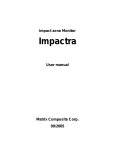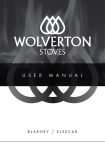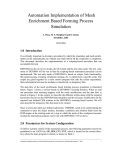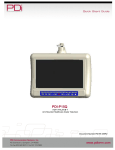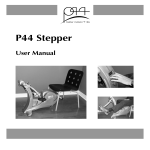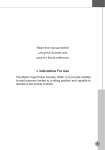Download Cleveland Golf Bending Machine
Transcript
User Manual Introduction The Cleveland Golf Portable Bending Machine (SCUBA) was developed to bend wedges and irons anywhere. More specifically, it can easily be taken to the driving range to bend clubs while fitting a player so he can have optimum wedge performance. Below is a brief description behind how it works along with instructions on how to use it. Science Behind the SCUBA The SCUBA bends clubs the exact way club fitters have been bending clubs for years. The club gets secured in a clamp, a bending bar torques the hosel, and the club plastically deforms (permanently bends). The only difference between the SCUBA and traditional bending is the force on the bending bar. Rather than a person pushing or pulling on the bending bar, a mechanical jack moves it (the jack can be driven by a drill or by hand). So why can’t a person push on the bending bar when using the SCUBA? Since the SCUBA is portable, it can’t be fixed to the ground like a traditional bending unit. If a person stands on the ground and pushes or pulls on the bending bar, the entire system will topple over. However, if the person were shrunk and stood on the SCUBA base plate, the base plate would act as the ground. Now, the clamping mechanism is fixed to the ground like a traditional bending machine and the device won’t topple over. Since we don’t have a very small, strong person to do the bending, we replaced him with a jack to do the work. The SCUBA basically pushes and pulls against itself rather than the ground during bending, so the ground doesn’t see any force and the device is portable. A Note on Spring Back Spring back is the term we use for the metal returning back toward its original structure after the bending load is released. In other words, you have to bend the club past where you want it to end up, and then it will spring back to the desired bend. Typically, we see 3° to 4° of spring back for a bend. So if the lie angle of a wedge is 65°, and we want to bend it upright 1°, we really have to bend it to 69°, then it will spring back 3° to 66° when the load is released. Why don’t clubs spring back when you bend them by hand? When clubs are bent, they always spring back some amount. It is a property of the metal that it will spring back when bent. However, when bending by hand, you don’t measure the club at all times so you just don’t realize that it is springing back. What a club fitter might feel and measure as a 1° bend, really was bent 4° at its peak, but then sprung back to only 1° net change when he stopped pushing on the bending bar. Instructions This instruction manual will take you through all the steps from transporting the SCUBA in your car to bending loft and lie. Packaging: For the most efficient travel size, stack the bend fixture, cart, then carrying case. Cart Setup: Unfold cart legs. Insert the 3 pins and tighten knobs to secure cart. 2 1 1 2 3 Place case on front of cart. 3 Set bend fixture on top of cart so 3 bolts come through holes, then fasten the ball nuts to the bolts. Transport: Before wheeling around, rotate the angle arm completely vertical and lock the sliding gauge to the center of the handle. To move, place your foot on cross bar and pull handle. Front leg will fold down for better balance. You can push or pull the cart to transport it. When setting it down. Place the front down first, then ease the back leg back toward you. SCUBA Setup: Open case and add contents to cart as shown. Turn on the digital gauge in the back. It will read 0.0 for both loft and lie. ON Every time you turn the gauge on, you must zero the loft and lie display. For loft, bring the angle arm as far forward as it goes so it is vertical, then press the “ZERO” button for loft. Angle Arm Forward For lie, insert the calibration pin through the cradle to secure it in place, then press the “ZERO” button for lie. The gauge will then be calibrated until you turn it off. Measuring Loft and Lie: A key component for accuracy is making sure the grooves are parallel to the cross bar. You can adjust the toe stop in and out to change this angle. To measure loft and lie, secure the club in the clamp, bring the cradle to the shaft, and rotate the entire clamp fixture until the shaft is flush to the cradle. At this point the shaft should be perfectly vertical. Not Flush Flush With the shaft perfectly flush with the cradle, the gauge will accurately read the loft and lie. Club Bending: NEVER TURN THE JACK PAST ITS LIMIT. Once the fabric boot is scrunched, don’t lower it any more. If the jack is the same height as the digital gauge, don’t turn it any higher. The result could damage the jack and be dangerous for the operator. Lower Limit Upper Limit Bending Loft: To bend loft, first you want to set your desired loft, then bend the club until the shaft is perfectly vertical and flush to the cradle. Rotate clamp to set the final loft you want If there is no gap between the shaft and cradle, the club is already the correct loft. If there is a gap, you need to bend the club until it is perfectly flush. Small gap between cradle and shaft means you need to bend it To bend, slide the jack into the X-Block so it is parallel to the shaft. Then slide the “loft” side of the bending bar over the hosel and the opposite end into the C-Hook of the jack. C-Hook X-Block Drive the jack up or down to bend the club strong or weak. Look at the gap between the shaft and cradle to see when the shaft is flush. Look at Gap Here Strong Weak The metal always wants to spring back, or rebound to where it originally was. As a result, you have to bend past where you want the shaft to end up, then when you relieve the pressure the metal will spring back to your desired bend. Before bend, small gap on top Bend past where you want to account for spring back, thus there is temporarily a gap on bottom Once you reverse the drill and relieve the pressure, the shaft should be perfectly flush with the cradle. If not, bend it again until it is. Bending Lie: Bending the lie angle is easier than bending loft. Slide the jack into the lie mount on the rights side of the machine, slide the “lie angle” side of the bending bar over the hosel, then rotate the opposite end into the C-Hook. C-Hook Lie End Loft End Drive the jack up or down depending on if you are bending the club upright or flat. Use the digital gauge to read the lie angle as you are bending. Bend the club to the desired lie angle, then go past by 2-4 degrees to account for spring back. Watch the digital gauge while bending Upright Flat Left Handed Bending: When bending loft on a left handed club, slide the gauge to the left side of the machine, screw the toe stop into the opposite side, and put the jack in the X-Block so it is parallel to the shaft. Still look at the gap between the shaft and cradle while bending. Look at Gap Here While Bending When bending lie on a left handed club, use the far left mount for the jack. Graphite Shafts: The magnetic cradle does not stay attached to graphite shafts, so you must hold the cradle up to the shaft while bending. Hand Crank: If the drill runs out of batteries, use the set screw to fasten the hand crank onto the jack. This takes longer than using the drill, but at least try it once to see how easy it is to bend the clubs. Bending Tips: When placing and removing the bending bar into the C-Hook, it helps to be using the drill with one hand, and the other hand trying to place or remove the bending bar. As soon as the jack is the proper height, the bending bar will slide in or out of the C-Hook. Clubs will always have some spring back, and the amount depends on the material and hosel geometry. In general, cast clubs will spring back 3° - 4°, while forged clubs spring back 1° - 2°.























